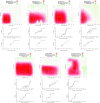Activity of fosfomycin and amikacin against fosfomycin-heteroresistant Escherichia coli strains in a hollow-fiber infection model
- PMID: 33685903
- PMCID: PMC8092889
- DOI: 10.1128/AAC.02213-20
Activity of fosfomycin and amikacin against fosfomycin-heteroresistant Escherichia coli strains in a hollow-fiber infection model
Abstract
Objectives:To evaluate human-like intravenous doses of fosfomycin (8g/Q8h) and amikacin (15mg/kg/Q24h) efficacy in monotherapy and in combination against six fosfomycin-heteroresistant Escherichia coli isolates using a hollow-fiber infection model (HFIM).Materials and methods:Six fosfomycin-heteroresistant E. coli isolates (4 with strong mutator phenotype) and the control strain E. coli ATCC 25922 were used. Mutant frequencies for rifampin (100mg/L), fosfomycin (50 and 200mg/L) and amikacin (32mg/L) were determined. Fosfomycin and amikacin MICs were assessed by agar dilution (AD), gradient strip (GSA) and broth microdilution (BMD) assays. Fosfomycin and amikacin synergies were studied by checkerboard and time-kill assays at different concentrations. Fosfomycin (8g/Q8h) and amikacin (15mg/kg/Q24h) efficacy alone and in combination were assessed using a HFIM.Results:Five isolates were resistant to fosfomycin by AD and BMD, but all susceptible by GSA. All isolates were considered susceptible to amikacin. Antibiotic combinations were synergistic in two isolates and no antagonism was detected. In time-kill assays, all isolates survived under fosfomycin at 64mg/L, although, at 307mg/L, only the normomutators and two hypermutators survived. Four isolates survived under 16mg/L amikacin and none at 45mg/L. No growth was detected under combination conditions. In HFIM, fosfomycin and amikacin monotherapies failed to sterilise bacterial cultures, however, fosfomycin and amikacin combination showed a rapid eradication.Conclusions.There may be a risk of treatment failure of fosfomycin-heteroresistant E. coli isolates using either amikacin or fosfomycin in monotherapy. These results support that the combination amikacin-fosfomycin can rapidly decrease bacterial burden and prevent the emergence of resistant subpopulations against fosfomycin-heteroresistant strains.
Copyright © 2021 American Society for Microbiology.
Figures


Similar articles
-
Contribution of hypermutation to fosfomycin heteroresistance in Escherichia coli.J Antimicrob Chemother. 2020 Aug 1;75(8):2066-2075. doi: 10.1093/jac/dkaa131. J Antimicrob Chemother. 2020. PMID: 32443144
-
Amikacin Combined with Fosfomycin for Treatment of Neonatal Sepsis in the Setting of Highly Prevalent Antimicrobial Resistance.Antimicrob Agents Chemother. 2021 Jun 17;65(7):e0029321. doi: 10.1128/AAC.00293-21. Epub 2021 Jun 17. Antimicrob Agents Chemother. 2021. PMID: 33972238 Free PMC article.
-
An in vitro experimental study of the effect of fosfomycin in combination with amikacin, ciprofloxacin or meropenem on biofilm formation by multidrug-resistant urinary isolates of Escherichia coli.J Med Microbiol. 2019 Dec;68(12):1699-1706. doi: 10.1099/jmm.0.001061. Epub 2019 Oct 18. J Med Microbiol. 2019. PMID: 31647407
-
Role of inoculum and mutant frequency on fosfomycin MIC discrepancies by agar dilution and broth microdilution methods in Enterobacteriaceae.Clin Microbiol Infect. 2017 May;23(5):325-331. doi: 10.1016/j.cmi.2016.12.022. Epub 2017 Jan 3. Clin Microbiol Infect. 2017. PMID: 28062317
-
Amikacin-fosfomycin at a five-to-two ratio: characterization of mutation rates in microbial strains causing ventilator-associated pneumonia and interactions with commonly used antibiotics.Antimicrob Agents Chemother. 2014 Jul;58(7):3708-13. doi: 10.1128/AAC.02779-13. Epub 2014 Apr 21. Antimicrob Agents Chemother. 2014. PMID: 24752276 Free PMC article.
Cited by
-
Effect of Glycerol on Fosfomycin Activity against Escherichia coli.Antibiotics (Basel). 2022 Nov 12;11(11):1612. doi: 10.3390/antibiotics11111612. Antibiotics (Basel). 2022. PMID: 36421256 Free PMC article.
-
Applications of the hollow-fibre infection model (HFIM) in viral infection studies.J Antimicrob Chemother. 2022 Dec 23;78(1):8-20. doi: 10.1093/jac/dkac394. J Antimicrob Chemother. 2022. PMID: 36411255 Free PMC article. Review.
-
Pharmacodynamics of Linezolid Plus Fosfomycin Against Vancomycin-Resistant Enterococcus faecium in a Hollow Fiber Infection Model.Front Microbiol. 2021 Dec 14;12:779885. doi: 10.3389/fmicb.2021.779885. eCollection 2021. Front Microbiol. 2021. PMID: 34970238 Free PMC article.
References
-
- Cassini A, Högberg LD, Plachouras D, Quattrocchi A, Hoxha A, Simonsen GS, Colomb-Cotinat M, Kretzschmar ME, Devleesschauwer B, Cecchini M, Ouakrim DA, Oliveira TC, Struelens MJ, Suetens C, Monnet DL, Strauss R, Mertens K, Struyf T, Catry B, Latour K, Ivanov IN, et al.. 2019. Attributable deaths and disability-adjusted life-years caused by infections with antibiotic-resistant bacteria in the EU and the European Economic Area in 2015: a population-level modeling analysis. Lancet Infect Dis 19:56–66. doi:10.1016/S1473-3099(18)30605-4. - DOI - PMC - PubMed
-
- O’Neill J. 2016. Review on antibiotic resistance. antimicrobial resistance: tackling a crisis for the health and wealth of nations. Review on Antimicrobial Resistance, London, United Kingdom. https://amr-review.org/sites/default/files/160525_Final%20paper_with%20c....
-
- Demirci-Duarte S, Unalan-Altintop T, Eser OK, Cakar A, Altun B, Sancak B, Gur D. 2020. Prevalence of O25b-ST131 clone and fosfomycin resistance in urinary Escherichia coli isolates and their relation to CTX-M determinant. Diagn Microbiol Infect Dis 98:115098. doi:10.1016/j.diagmicrobio.2020.115098. - DOI - PubMed
-
- Clinical Laboratory Standard Institute. 2020. Performance standards for antimicrobial susceptibility testing, 30th ed. CLSI supplement M100. Clinical and Laboratory Standards Institute, Wayne, PA.
LinkOut - more resources
Full Text Sources
Other Literature Sources

